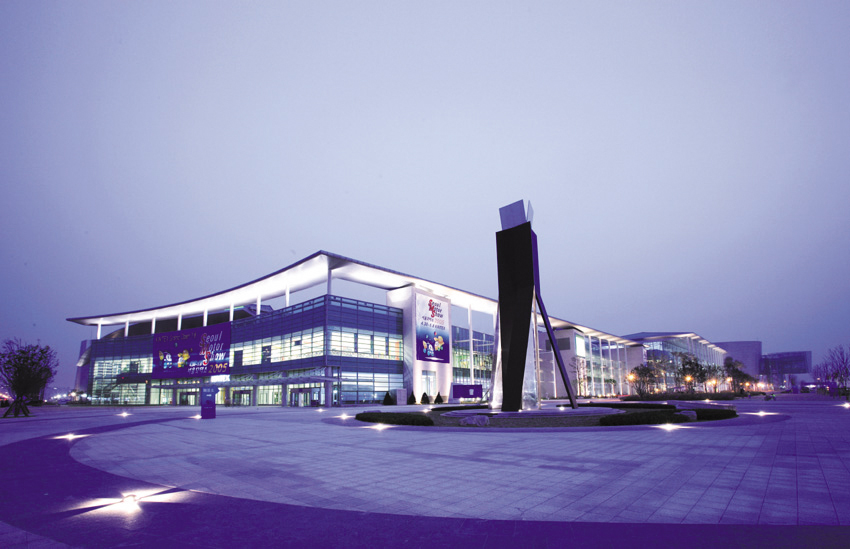Korea Premium, The
Exhibition Industry
KINTEX to expand its space to hold large exhibitions next year
 CeBit, an international festival of information and communication, held in Hanover, Germany, is the top exhibition of the latest information and communication technologies in the world. The exhibition not only played a big part in making Hanover world famous, but the economic benefits of holding the annual expo were so enormous that people say the event virtually provided a livelihood for a city with some half-million population.
CeBit, an international festival of information and communication, held in Hanover, Germany, is the top exhibition of the latest information and communication technologies in the world. The exhibition not only played a big part in making Hanover world famous, but the economic benefits of holding the annual expo were so enormous that people say the event virtually provided a livelihood for a city with some half-million population.
The example of CeBit is an excellent one to show the enormous strength that an exhibition can have on an industry and a country. As such, the exhibition and convention industry is being regarded as a high value-added industry that will lay a golden egg in the 21st century.
Among Asian countries, Singapore and Hong Kong learned the importance of the industry a decade ago and have been nurturing it with government support as one of their strategic industries.
How is the situation in our country?
Korea ranks 12th in terms of international trade, but the share of its exhibition and convention industry in the GDP came only to a mere 0.7 percent. It seems somewhat late, but the industry is being developed with government support as a national strategic industry. In fact, just before the opening of KINTEX, President Roh recognized the need for the development of the industry in conjunction with the tourism industry as a high value-added industry, pledging that the government will form a strategy to develop it as a national strategic industry.
The exhibition-convention industry is the only industry that can be supported with funds under the World Trade Organization (WTO) system. Therefore, the industry is considered trade infrastructure which backs up trading by playing an important function, in addition to being regarded as a highly diversified value-added industry.
There are many ways to measure the economic effects of the industry, but traditionally, it amounts to 10 times the revenue of an exhibition and convention center.
 It is already a well-known fact that 60 percent to 70 percent of Germany total trade is produced by the exhibition-convention industry. In the case of the United States, the industry direct revenue amounted to $64.6 billion, providing some 990,000 jobs.
It is already a well-known fact that 60 percent to 70 percent of Germany total trade is produced by the exhibition-convention industry. In the case of the United States, the industry direct revenue amounted to $64.6 billion, providing some 990,000 jobs.
The attraction of large international meetings and exhibitions has the effect of boosting the host city reputation, enhancing the city marketing efforts.
Countries in Northeast Asia are busy competing to attract international conventions and other events to their cities, which shows that the industry not only helps increase the host country exports, but also boosts the country image, spurring the development of their tourism and transportation sectors.
Hong Kong has been making steady progress in hosting international exhibitions while under the shade of the Chinese economy. Japan, too, has been making inroads into international markets and attracting international exhibitions. In particular, it especially worth looking at the growth of China exhibition industry. Last year, the country built some 3 million square meters of exhibition space, equivalent to those of Germany. Cities like Shanghai, Beijing and Guangjou were busy hosting large-scale international exhibitions last year and their numbers have been rising.
KINTEX, opened in 2005, is the largest in Korea, but is just short of staging large international exhibitions, unable to offer 100,000 square meters in scale. But when expansion plans for the complex are completed, it will be capable of staging large international exhibitions including the ITU Telecom World and ITMA. It will be able to secure high value-added cultural content when the Hallyuwood project is completed nearby, enhancing its competitive strength.
Korea exhibition industry is considered to be in the growth stage. When viewed from the special nature of domestic industries, Korea will be able to establish itself as an xhibition Hub in Northeast Asia. The time is ripe for Korea as a strong IT country with the trend for the fusion of IT with various sectors of industry including automobile, machinery, chemical and medicine, sweeping the world.
The most popular booths at the Consumer Electronics Show in Las Vegas belonged to Samsung Electronics and LG Electronics. Our country, with Samsung and LG, has a greater chance to stage better international exhibitions than most other countries.
We should proceed with our efforts to develop a Korean-brand exhibition representing Korea like a watch and jewelry exhibition does for Hong Kong and a furniture exhibition does for Milan. nw
Kim In-shik,
president of KINTEX
A view of KINTEX in Ilsan north of Seoul.
3Fl, 292-47, Shindang 6-dong, Chung-gu, Seoul, Korea 100-456
Tel : 82-2-2235-6114 / Fax : 82-2-2235-0799